Pesticide usage in Scotland 2016: soft fruit crops
A revised version of this report has been issued to correct inaccuracies in active substance application weight data that were overestimated in the original report. This issue only affects certain herbicide active substances in relation to quantity applied. Please do not use the original version of this report as this has now been replaced by the revised 2020 report: Pesticide usage in Scotland 2016: soft fruit crops – revised 2020.
This publication presents information from a survey of pesticide use on soft fruit crops grown in Scotland during 2016.
General trends
Trends relating to crop area and total pesticide use are discussed in this section. It should be noted the previous survey in 2014 (3) was the first soft fruit report to contain data from both non-protected and protected soft fruit crops. To allow some longer-term comparisons, non-protected and semi-protected crop data from the 2012 Soft Fruit Crop survey (4) have been amalgamated with protected soft fruit crop data from the 2011 Protected Edible survey (5) . However, as the soft fruit crops in 2011 and 2012 will have experienced different pest pressure and climatic conditions, these trends should be treated with caution. Data users should also be aware that there have been differences in crop range, crop areas and methods used for estimating pesticide use between surveys (see Appendix 4 for details).
Crop area
The estimated area of soft fruit crops grown in 2016 was 1,876 hectares. This represents a four per cent increase from 2014 and a 13 per cent increase from 2011/12 ( Table 36). No multi-cropping was encountered during the 2016 survey. Since the last survey the areas of blueberries, strawberries and raspberries increased (192, nine and five per cent respectively); while the areas of mixed/other soft fruit and blackcurrants decreased (27 and two per cent respectively, Figure 1).
In the current survey, strawberries accounted for 53 per cent of the soft fruit area, raspberries 18 per cent, blackcurrants 16 per cent and other soft fruit crops (blueberries, blackberries, gooseberries, redcurrants and other minor crops) 13 per cent ( Figure 2).
Figure 1: Census area of soft fruit crops grown in Scotland 2014-2016
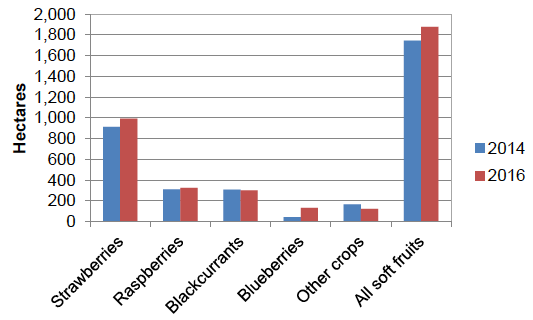
Note: Areas include both non-protected and protected crops. Multi-cropping is not included.
Figure 2: Soft fruit areas 2016 (Percentage of total area)
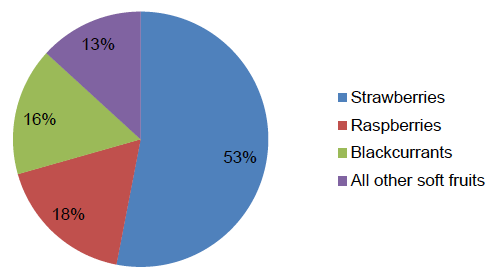
Pesticide usage
The majority of soft fruit crops (94 per cent) received a pesticide treatment in 2016. Blackcurrants had the highest proportion of crop treated with a pesticide ( Table 1, Figure 9) followed by strawberries, raspberries and other soft fruit crops (99, 96, 92 & 84 per cent respectively). In terms of average number of applications of pesticides, the treated area of soft fruit crops received on average 9.3 sprays. It should be noted this applies only to the treated proportion of the crop (94 per cent). Strawberries received the highest number of applications with an average 11.3 sprays. In contrast, the all other soft fruit category received the lowest number of sprays, 5.8 on average ( Table 1, Figure 10).
It is estimated that the area of soft fruit crops treated with a pesticide formulation in 2016 was ca. 26,000 hectares compared with ca. 36,800 hectares in 2014 and ca. 34,500 hectares in 2011/12 ( Table 35). This represents a decrease of 29 per cent since 2014 and 25 per cent since 2011/12. In terms of weight of pesticide applied 14.7 tonnes were applied in 2016, representing a decrease of 40 per cent from 2014 and 30 per cent from 2011/12
In order to make accurate comparisons between the 2016 data and the data collected in previous surveys, it is important to take into account differences in crop areas between the years. Therefore, the number of treated hectares per hectare of crop grown and the total weight of pesticide used per hectare of crop grown were calculated. Once the crop area has been taken into account there has been a decrease in the area and weight of pesticides applied ( Figures 5 & 8). In 2016, for each hectare of crop grown, around 14 pesticide treated hectares were recorded ( Figure 5). This represents a decrease of 32 per cent from 2014 and 33 per cent from 2011/12. The estimated quantity of pesticides applied per hectare of crop grown was approximately 8 kilograms ( Figure 8). This represents a decrease of 42 per cent since 2014 and 38 per cent since 2011/12. This reduction in pesticide use may have been influenced by factors such as cooler climatic conditions and lower pest pressure. However, it should be noted that it may also have been influenced by the size and distribution of the sample. In 2016 the response rate of growers participating in the survey ( Table 47) was much lower than in previous surveys (53 and 68 per cent respectively). As a result, the sample in 2016 represented 21 per cent of the total crop area grown, compared with 33 per cent in the previous survey. In addition, in 2016 the proportion of holdings in the larger size groups, which tend to have more intensive pesticide use, was lower than in the previous survey. Despite these changes to the sample in 2016, the similar relative standard errors for total soft fruit reported between the last two surveys provides some reassurance that the statistical robustness of the data has not been compromised ( Table 47).
Fungicides were the most frequently used pesticides, followed by insecticides/acaricides and then herbicides ( Figure 3). This is the same pattern as was observed in the previous two surveys. In 2016, fungicides accounted for 53 per cent of the total pesticide treated area and 48 per cent of the total weight of active substance applied ( Figure 6). When the changes in crop area are taken into account, the area treated with fungicide formulations decreased by 29 per cent from 2014 to 2016 and 36 per cent between 2011/12 and 2016 ( Figure 5). From 2014 to 2016, the weight of fungicides applied per hectare of crop grown halved ( Figure 8). From 2011/12 to 2016, there was a decrease of 56 per cent in the quantity of fungicides used per hectare of crop grown. The decreased use of fungicides in 2016 may partly be explained by the weather. The east Scotland experienced a slow cold spring, with much lower temperatures in the spring and summer and lower rainfall levels in the spring compared with 2014 (6) which may have resulted in decreased use of disease control measures.
In 2016, sulphur accounted for three per cent of the total pesticide treated area and a quarter of the total weight of active substance applied ( Figures 3 & 6). When crop area is taken into account the mean applications of sulphur were 2.0 kg/ha in 2016, 3.3 kg/ha in 2014 and 1.9 kg/ha in 2011/12. The rise in use of sulphur in 2014 was primarily due to the increased use of sulphur on blackcurrants for the control of big bud mite (3) , which was not cited as a reason for pesticide use in 2016.
Insecticides and acaricides accounted for 22 per cent of the total pesticide treated area but only three per cent of the total weight of active substance applied ( Figures 3 & 6). When changes in area of crop grown are taken into account, there is a 42 per cent decrease from 2014 to 2016 and a 34 per cent decrease from 2011/12 to 2016 in the area treated with insecticide/acaricide formulations ( Figure 5). In terms of weight of active substance applied, when area of crop is taken into account, there was a decrease of 70 per cent from 2014 to 2016 and a similar decrease (69 per cent) from 2011/12 ( Figure 8). Cooler temperatures in the east of Scotland during the spring and summer of 2016 compared with 2014 (6) may have kept insect pest populations in check. In addition, a large reduction in the use of organophosphates which were applied at high dose rates, may partly explain why the weight of insecticides has declined more than the area treated. Previously, the principal organophosphate used on soft fruit crops was chlorpyrifos. The Chemical Regulation Directorate ( CRD) has withdrawn all commercial uses for all products containing chlorpyrifos in the UK, with the exception of gantry sprays on brassica plants. Therefore all products containing chlorpyrifos had to be used on soft fruit crops before the 31 st of March 2016 and were not available for the majority of the growing season.
In 2016, herbicides accounted for 15 per cent of the total pesticide treated area and 23 per cent of the total weight of active substances applied ( Figures 3 & 6). When changes in crop area are taken into account, there is a decrease in area treated with herbicide formulations of 11 per cent from 2014 to 2016 and an increase of six per cent from 2011/12 to 2016 ( Figure 5). In terms of weight of active substance applied, when area of crop grown is taken into account, there was an increase of three per cent from 2014 to 2016 and an increase of 52 per cent from 2011/12 to 2016 ( Figure 8). Herbicide use in the previous survey was higher than average due to mild weather conditions which increased weed pressure but also due to the number of table top grown crops encountered in the survey (3) . Herbicides are frequently used in tunnels under table top grown strawberries. There was a reduction in the number of table top grown crops encountered in 2016 sample compared to 2014 (44 per cent of sampled strawberry area verses 60 per cent in 2014) which may have influenced the herbicide use estimate.
Biological control agents and biopesticides each accounted for three per cent of the total pesticide treated area ( Figure 3). Thirty per cent of the total soft fruit crop was treated with a biological (either a biopesticide or a biological control agent – see appendix 3 for a definition). When changes in crop area are taken into account, the area treated with biological control agents increased by 28 per cent from 2014 to 2016 and by 29 per cent from 2011/12 to 2016. An increased awareness of integrated pest management techniques, and a decline in the number of active substances available to soft fruit growers, may have influenced the increased use of biological control agents. In contrast the area treated with biopesticides decreased by 54 per cent from 2014 and by 58 per cent from 2011/12 ( Figure 5). Just over half (51 per cent) of the total soft fruit area treated with a biological was for the control of disease with the remainder for the control of invertebrate pests.
Molluscicides accounted for one per cent of the total pesticide treated area ( Figure 3). When changes in crop area are taken into account, the area treated with molluscicide formulations decreased by almost a third (32 per cent) between 2014 and 2016 and by almost two thirds (65 per cent) between 2011/12 and 2016. The quantity of molluscicides applied per hectare of crop grown decreased by 40 per cent from 2014 to 2016 and by 69 per cent from 2011/12 to 2016.
As well as changes in overall trends in application of pesticide groups since the previous survey, there has been variation in the use of individual active substances. For example, the use of the fungicide myclobutanil, the most commonly used active substance, decreased by 16 per cent in terms of area treated and 18 per cent in terms of quantity of active substance applied ( Tables 33 & 34). The fungicide potassium hydrogen carbonate, decreased by 85 per cent in terms of area treated and by 79 per cent in terms of quantity applied. The fungicide cyflufenamid was recorded in this survey series for the first time. The biological control agents, Aphidoletes aphidimyza and Neoseilus californicus and the biopesticide Beauveria bassiana GHA were also recorded for the first time on soft fruit crops in 2016 ( Table 35). The most commonly used herbicide, diquat, declined by 30 per cent in terms of area treated and by 33 per cent by quantity applied. In contrast, the herbicides isoxaben, napropamide and glyphosate increased by 319, 136 and 93 per cent respectively in terms of area treated and by 243, 115 and 115 per cent respectively by quantity of active substance applied.
For the first time in this series of reports, insecticides, fungicides and herbicides have been classified into groups according to their mode of action ( Tables 30- 32).
Figure 3: Use of pesticides on soft fruit crops (percentage of total area treated with formulations) - 2016
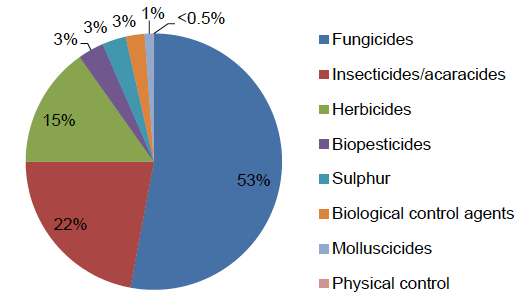
Figure 4: Area of soft fruit crops treated with the major pesticide groups in Scotland 2011/12 - 2016
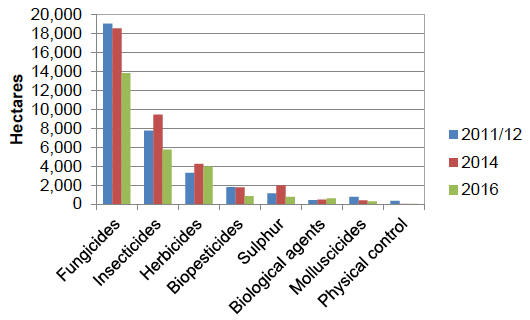
Note: Insecticides include acaricides
Figure 5: Number of pesticide treated hectares (formulations) per each hectare of crop grown 2011/12-2016
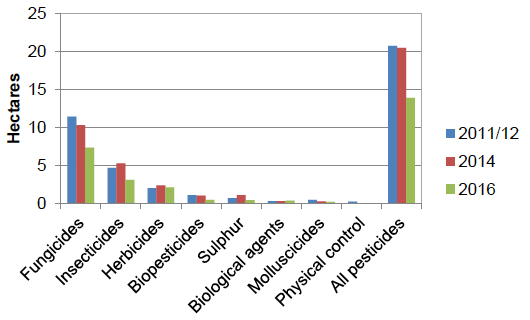
Note: Insecticides include acaricides
Figure 6: Use of pesticides on soft fruit crops (percentage of total quantity of active substances applied) - 2016
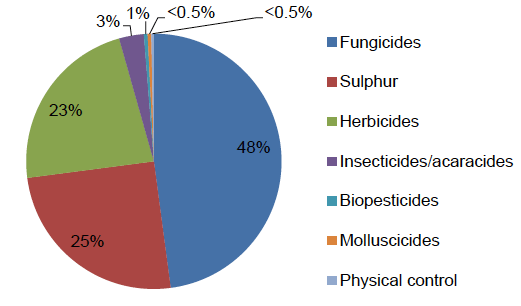
Note: invertebrate biological control agents are applied by number of organisms rather than weight therefore data are not presented
Figure 7: Quantity of the major pesticide groups applied to soft fruit crops in Scotland 2011/12-2016
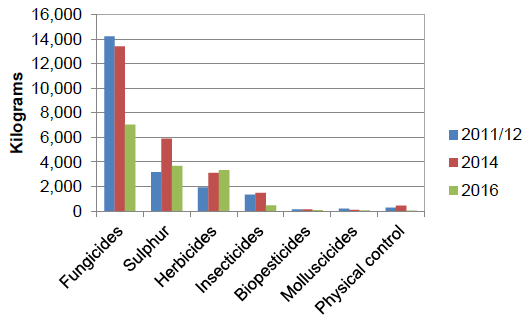
Note: invertebrate biological control agents are applied by number of organisms rather than weight therefore data are not presented. Insecticides include acaricides.
Figure 8: Weight of pesticide (kg) applied per hectare of crop grown 2011/12-16
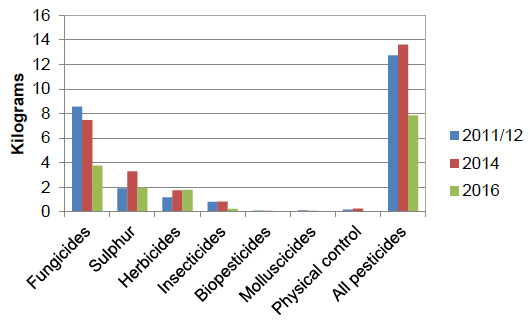
Note: Insecticides include acaricides
Figure 9: Percentage of soft fruit crops treated with pesticides - 2016
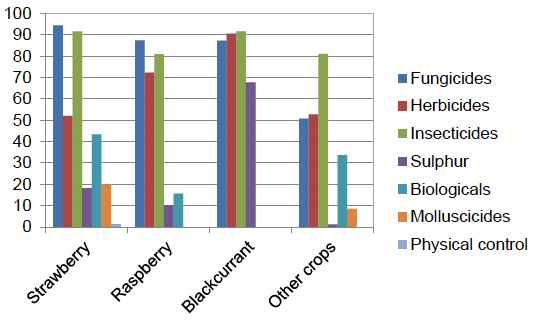
Note: Insecticides include acaricides. Biologicals includes biopesticides and biological control agents
Figure 10: Average number of pesticide applications on treated area of soft fruit crops - 2016
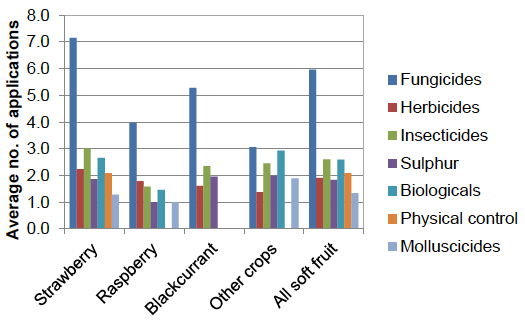
Note: Insecticides include acaricides. Biologicals includes biopesticides and biological control agents
Integrated pest management
For the first time in this series of surveys, additional data collection was conducted in relation to grower adoption of Integrated Pest Management ( IPM) measures. This is a summary of the data; please refer to Appendix 6 for the full dataset. Growers were asked a series of questions about the IPM activities that they implemented for their soft fruit crop production. Unlike the other statistics in this report, the figures relating to IPM are not raised (i.e. are not national estimates) but represent only the responses of those surveyed.
In total IPM data was collected from 28 growers, representing 33 holdings and 68 per cent of the sampled soft fruit crop area (14 per cent of the census area). Of these growers, 82 per cent did not have an IPM plan, 11 per cent of growers completed their own IPM plan and seven per cent had a plan completed by their agronomist ( Figure 42). Despite the majority of growers not completing an IPM plan uptake of a wide range of IPM activities was encountered. Growers were asked about their IPM activities in relation to three categories; risk management, pest monitoring and pest control.
A number of risk management measures were reported by the growers surveyed ( Table 50). Just over half (54 per cent) of all growers used crop rotation to manage the risk of pest damage. A similar proportion (54 per cent) of growers tested their soils in order to tailor inputs to improve crop performance. 61 per cent of growers managed their seed bed agronomy to reduce risk. Almost 40 per cent of growers amended cultivation methods at sowing to try to increase crop success. 57 per cent of the growers surveyed also considered risk management when selecting seeds and/or varieties. Almost 30 per cent of respondents sowed catch or cover crops as part of their crop production cycle. Eighty two per cent of growers sampled adopted techniques to protect or enhance populations of beneficial insects and almost a third of growers manipulated environmental factors to control pest risk. The majority (93 per cent) of respondents adopted good crop hygiene techniques to reduce risk.
A number of pest monitoring activities were also recorded ( Table 51). Seventy one per cent of growers reported that they regularly monitored crop growth stages and 86 per cent monitored and identified pests on their crops. Over a third (39 per cent) of respondents also used specialist diagnostics when dealing with pests that were more problematic to identify or monitor.
The pest control measures reported by the growers surveyed are presented in Table 52. Almost all of the growers (96 per cent) used non-chemical control in partnership or instead of chemical control. Almost half (46 per cent) of growers stated that they targeted their pesticide applications using monitoring data. In addition, almost a third of growers stated that they followed anti-resistance strategies. Finally, 71 per cent of growers stated that they monitored the success of their crop protection measures.
Contact
There is a problem
Thanks for your feedback